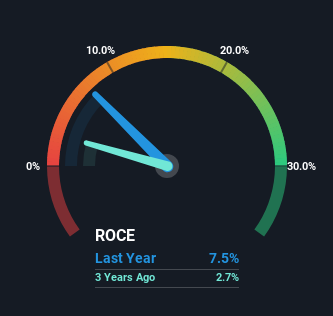- Singapore
- /
- Hospitality
- /
- SGX:G13
These Return Metrics Don't Make Genting Singapore (SGX:G13) Look Too Strong
What underlying fundamental trends can indicate that a company might be in decline? When we see a declining return on capital employed (ROCE) in conjunction with a declining base of capital employed, that's often how a mature business shows signs of aging. This indicates to us that the business is not only shrinking the size of its net assets, but its returns are falling as well. So after glancing at the trends within Genting Singapore (SGX:G13), we weren't too hopeful.
Return On Capital Employed (ROCE): What Is It?
Just to clarify if you're unsure, ROCE is a metric for evaluating how much pre-tax income (in percentage terms) a company earns on the capital invested in its business. To calculate this metric for Genting Singapore, this is the formula:
Return on Capital Employed = Earnings Before Interest and Tax (EBIT) ÷ (Total Assets - Current Liabilities)
0.075 = S$617m ÷ (S$8.9b - S$626m) (Based on the trailing twelve months to June 2023).
Therefore, Genting Singapore has an ROCE of 7.5%. In absolute terms, that's a low return, but it's much better than the Hospitality industry average of 3.9%.
Check out our latest analysis for Genting Singapore

In the above chart we have measured Genting Singapore's prior ROCE against its prior performance, but the future is arguably more important. If you'd like to see what analysts are forecasting going forward, you should check out our free report for Genting Singapore.
What The Trend Of ROCE Can Tell Us
We are a bit worried about the trend of returns on capital at Genting Singapore. Unfortunately the returns on capital have diminished from the 9.7% that they were earning five years ago. And on the capital employed front, the business is utilizing roughly the same amount of capital as it was back then. Companies that exhibit these attributes tend to not be shrinking, but they can be mature and facing pressure on their margins from competition. So because these trends aren't typically conducive to creating a multi-bagger, we wouldn't hold our breath on Genting Singapore becoming one if things continue as they have.
The Key Takeaway
In summary, it's unfortunate that Genting Singapore is generating lower returns from the same amount of capital. And long term shareholders have watched their investments stay flat over the last five years. That being the case, unless the underlying trends revert to a more positive trajectory, we'd consider looking elsewhere.
One more thing, we've spotted 1 warning sign facing Genting Singapore that you might find interesting.
If you want to search for solid companies with great earnings, check out this free list of companies with good balance sheets and impressive returns on equity.
New: Manage All Your Stock Portfolios in One Place
We've created the ultimate portfolio companion for stock investors, and it's free.
• Connect an unlimited number of Portfolios and see your total in one currency
• Be alerted to new Warning Signs or Risks via email or mobile
• Track the Fair Value of your stocks
Have feedback on this article? Concerned about the content? Get in touch with us directly. Alternatively, email editorial-team (at) simplywallst.com.
This article by Simply Wall St is general in nature. We provide commentary based on historical data and analyst forecasts only using an unbiased methodology and our articles are not intended to be financial advice. It does not constitute a recommendation to buy or sell any stock, and does not take account of your objectives, or your financial situation. We aim to bring you long-term focused analysis driven by fundamental data. Note that our analysis may not factor in the latest price-sensitive company announcements or qualitative material. Simply Wall St has no position in any stocks mentioned.
About SGX:G13
Genting Singapore
An investment holding company, primarily engages in the development, management, and operation of integrated resort destinations in Asia.
Flawless balance sheet and good value.
Similar Companies
Market Insights
Community Narratives



